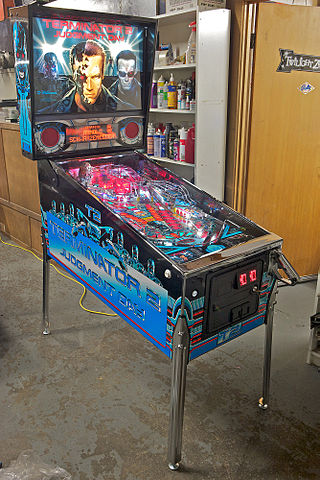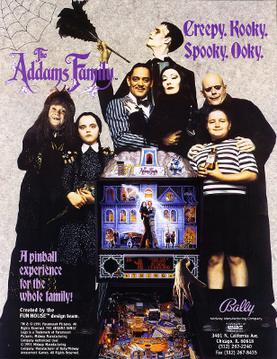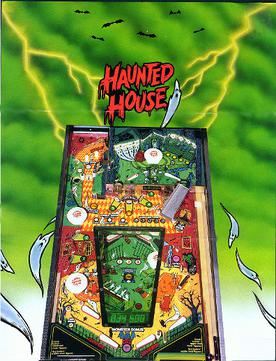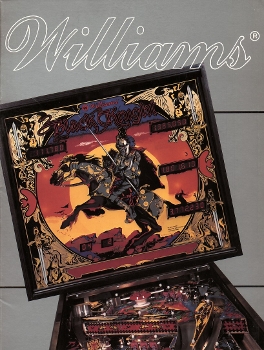
Pinball games are a family of games in which a ball is propelled into a specially designed table where it bounces off various obstacles, scoring points either en route or when it comes to rest. Historically the board was studded with nails called 'pins' and had hollows or pockets which scored points if the ball came to rest in them. Today, pinball is most commonly an arcade game in which the ball is fired into a specially designed cabinet known as a pinball machine, hitting various lights, bumpers, ramps, and other targets depending on its design. The game's object is generally to score as many points as possible by hitting these targets and making various shots with flippers before the ball is lost. Most pinball machines use one ball per turn, and the game ends when the ball(s) from the last turn are lost. The biggest pinball machine manufacturers historically include Bally Manufacturing, Gottlieb, Williams Electronics and Stern Pinball.

Gilbert J.Clarke is an American guitarist, singer, songwriter and record producer. He had a three-year tenure as the rhythm guitarist of Guns N' Roses, replacing Izzy Stradlin in 1991 during the Use Your Illusion Tour, and also featured on "The Spaghetti Incident?" (1993). Following this, Clarke went on to forge a solo career as well playing guitar with Slash's Snakepit, Kat Men, Heart, Nancy Sinatra, Kathy Valentine, MC5 and forming his own group Rock Star Supernova with members of Metallica and Mötley Crüe.
A glossary of terms, commonly used in discussing pinball machines.

The Addams Family is a pinball machine released in March 1992. It was designed by Pat Lawlor and Larry DeMar and released by Midway. It was based on the 1991 film of the same name, and features custom speech by the stars of the film, Anjelica Huston and Raul Julia. It is the best-selling solid state pinball machine of all time with 20,270 units sold.

Haunted House is a pinball game released in October 31 1982 by Gottlieb. It was the first game with three playfields that the ball can move between, including one below the main playing surface. Haunted House was designed by John Osborne, with artwork by Terry Doerzaph. It is part of Gottlieb’s “System 80” series of pinball machines.

Black Knight is a 1980 pinball machine designed by Steve Ritchie and released by Williams Electronics. Ritchie designed two sequels: Black Knight 2000, released by Williams in 1989, and Black Knight: Sword of Rage, released by Stern Pinball in 2019.
The Simpsons is a 1990 pinball game released by Data East Pinball. It is based on the animated sitcom The Simpsons and features many elements from the series, such as character voices and music. The game was popular in the United States, becoming a hit for Data East Pinball. It has been cited as helping increase the popularity of pinball machines at the beginning of the 1990s. The Simpsons pinball game was followed by The Simpsons Pinball Party in 2003.
Gilligan's Island is a Midway pinball machine released in May 1991. It is based on the television series of the same name and the first Williams WPC machine that was released with a high resolution (128x32) dot matrix display. Bob Denver supplied original speech for the game which also featured the theme song from the television show. Tina Louise refused to lend her likeness and an alternate blonde character appears on the backglass of the machine.
Batman Forever is a pinball machine released in June 1995 by Sega Pinball. It is based on the motion picture of the same name.

Checkpoint is a 1991 pinball machine released by Data East. It featured the first dot matrix display (DMD) ever incorporated into a pinball game. For Checkpoint, Data East used a "half-height" DMD. By way of comparison, Williams later produced machines with standard DMDs that were twice the height. Checkpoint also features video mode minigames on its display.

Last Action Hero is a pinball machine designed by Joe Kaminkow and produced by Data East Pinball. It is based on the motion picture of the same name.
Jungle Lord is a 1981 pinball machine designed by Barry Oursler and produced by Williams Pinball. It features a Tarzan influenced theme, a multi-level playfield and a magnetic ball saver. Williams had introduced Magna Save in the Black Knight pinball game in 1980; Jungle Lord was one of four further Magna Save games produced in 1981, along with Pharaoh, Solar Fire and Grand Lizard. One difference from the Black Knight design was that Jungle Lord incorporated a "self-contained mini bagatelle style 'chamber' playfield, found on the top left-hand corner."
Police Force is a 1989 Williams pinball machine. The pinball machine was initially supposed to be released as Batman pinball, the police car was to be the Batmobile and the Jail was to be the Bat Cave. The machine features anthropomorphic jungle animals in the roles of police and robbers.

Comet is a pinball machine released by Williams in June 1985. It was designed by Barry Oursler, who was inspired by the Comet roller coaster at Riverview Park in Chicago, and was the first in an amusement park themed pinball trilogy followed by Cyclone in 1988 and Hurricane in 1991.

Harley-Davidson is a Sega Pinball pinball machine released in September 1999 and was the last machine released by this company. It was designed by Jon Borg and Lonnie D. Ropp.

The Phantom of the Opera is a pinball machine released by Data East in 1990. The game is based on the 1910 French novel The Phantom of the Opera by Gaston Leroux, but not based on the 1986 musical by Andrew Lloyd Webber or movie of the same name, although released around the same time. The game was designed by Joe Kaminkow and Ed Cebula.

Rescue 911 is a pinball machine designed by Bill Parker and released by Gottlieb in 1994. The game is based on the TV show of the same name.
Time Warp is a 4 player Solid State Electronic pinball machine from September 1979 produced by Williams. A total of 8,875 units were produced.
Bugs Bunny's Birthday Ball is a 1990 pinball game designed by John Trudeau and Python Anghelo and released by Midway. It is based on Warner Bros.' Looney Tunes and Merrie Melodies series of cartoons. This is the first of only two licensed pinball tables ever to feature the Looney Tunes characters.
WWF Royal Rumble is a pinball machine designed by Tim Seckel and released by Data East in April 1994.












